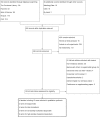A Systematic Review and Meta-analysis of Randomized Controlled Trials on the Effects of Turmeric and Curcuminoids on Blood Lipids in Adults with Metabolic Diseases
- PMID: 31212316
- PMCID: PMC6743846
- DOI: 10.1093/advances/nmz021
A Systematic Review and Meta-analysis of Randomized Controlled Trials on the Effects of Turmeric and Curcuminoids on Blood Lipids in Adults with Metabolic Diseases
Abstract
Dyslipidemia is a global health problem and a high risk factor for atherosclerosis, which can lead to serious cardiovascular disease (CVD). Existing studies have shown inconsistent effects of turmeric and curcuminoids on blood lipids in adults. We performed this systematic review and meta-analysis to evaluate the effects of turmeric and curcuminoids on blood triglycerides (TG), total cholesterol (TC), LDL cholesterol, and HDL cholesterol. We searched the English databases of the Web of Science, PubMed, Ovid (including EMBASE and MEDLINE), Scopus, and the Cochrane Library and 2 Chinese databases, Wanfang Data and China National Knowledge Infrastructure, for randomized controlled trials (RCTs) that studied the effects of turmeric and curcuminoids on blood TG, TC, LDL cholesterol, and HDL cholesterol in subjects with metabolic diseases. With random-effects models, separate meta-analyses were conducted by using inverse-variance. The results are presented as the mean difference with 95% CIs. Evidence from 12 RCTs for TG, 14 RCTs for TC, 13 RCTs for LDL cholesterol, and 16 RCTs for HDL cholesterol showed that turmeric and curcuminoids could lower blood TG by -19.1 mg/dL (95% CI: -31.7, -6.46 mg/dL; P = 0.003), TC by -11.4 mg/dL (95% CI: -17.1, -5.74 mg/dL; P < 0.0001), and LDL cholesterol by -9.83 mg/dL (95% CI: -15.9, -3.74 mg/dL; P = 0.002), and increase HDL cholesterol by 1.9 mg/dL (95% CI: 0.31, 3.49 mg/dL; P = 0.02). In conclusion, turmeric and curcuminoids can significantly modulate blood lipids in adults with metabolic diseases. However, these findings should be interpreted cautiously because of the significant heterogeneity between included studies (I2 > 50%). There is a need for further RCTs in future.
Keywords: HDL cholesterol; LDL cholesterol; curcuminoids; lipids; total cholesterol; triglyceride; turmeric.
Copyright © American Society for Nutrition 2019.
Figures





References
-
- Rothschild J, Hoddy KK, Jambazian P, Varady KA. Time-restricted feeding and risk of metabolic disease: a review of human and animal studies. Nutr Rev. 2014;72:308–18. - PubMed
-
- Raslova K. Diabetes and dyslipidemia: Why are they so closely related?. Vnitr Lek. 2016;62:908–11. - PubMed
-
- Casavalle PL, Lifshitz F, Romano LS, Pandolfo M, Caamano A, Boyer PM, Rodriguez PN, Friedman SM. Prevalence of dyslipidemia and metabolic syndrome risk factor in overweight and obese children. Pediatr Endocrinol Rev. 2014;12:213–23. - PubMed
Publication types
MeSH terms
Substances
LinkOut - more resources
Full Text Sources
Medical
Miscellaneous

